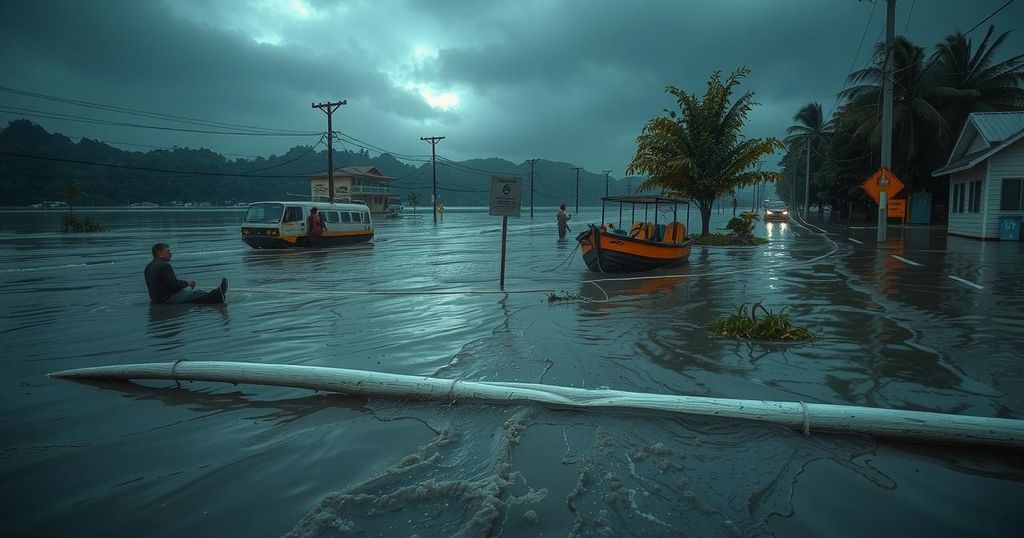Tropical Cyclone Kristine Causes Catastrophic Flooding in the Philippines
Tropical cyclone Kristine has caused severe flooding in northern Philippines, resulting in more than a dozen fatalities and affecting over one million residents. The storm, known as Tropical Storm Trami internationally, heightened vulnerabilities in the region already impacted by previous cyclones and heavy rainfall. Rescue efforts are ongoing as communities grapple with the aftermath of extensive flooding.
Tropical cyclone Kristine has wrought devastating effects in the northern Philippines, resulting in the tragic loss of over a dozen lives and leaving several individuals unaccounted for. Reports from the National Disaster Risk Reduction and Management Council indicate that the storm has adversely affected more than a million residents, with thousands likely facing displacement due to landslides and severe rainfall. Known domestically as ‘Kristine’ and referred to as Tropical Storm Trami by the Joint Typhoon Warning Center, this climatic event initiated west of Guam before making landfall in the northern regions of the Philippines on Wednesday. Government officials conveyed concerns that prior cyclonic activity, combined with the heavy rainfall preceding Kristine, has heightened the potential for flash flooding in the area. Devastation is vividly represented in reports and visuals showcasing residents navigating chest-deep floodwaters, with the Coast Guard mobilizing to assist in evacuations using boats. “People have been stuck on the roofs of their houses for several hours now. Many of our rescue trucks have stalled due to the floods,” noted Maria Leonor Robredo, the former vice president, in a poignant social media update. The Philippine Atmospheric, Geophysical and Astronomical Services Administration anticipates daily rainfall rates exceeding five inches in locations where storm bands converge. While Manila, which houses nearly 14 million residents, sits on the southern fringe of the storm’s moisture influence, expected rainfall is predicted as the cyclone advances westward across the archipelago. Despite the deteriorating remnants of Kristine now moving away from the islands, precipitation forecasts remain high due to the ongoing rainy season in the region. Historical climatological data suggests that Manila experiences an annual average of approximately 100 inches of rainfall, with dry conditions typically spanning winter and spring. While immediate damage assessments have not been disclosed, disaster officials anticipate significant losses as many communities endure extensive flooding. The Philippines, witnessing a surge in tropical cyclone activity, is projected to track between 13 to 18 cyclones during the 2024 season. As of now, at least ten cyclones have impacted the archipelago with over two months left in the year. A prevailing neutral state of the El Niño-Southern Oscillation seemingly contributed to the high cyclone activity levels observed this year.
The Philippines is particularly vulnerable to tropical cyclones due to its geographic location in the Pacific region, which is frequently affected by such weather events. The country’s terrain, comprised of numerous islands and mountainous regions, exacerbates the effects of heavy rainfall leading to floods and landslides. Meteorological data emphasizes that the rainy season, specifically during the latter part of the year, can significantly amplify the impact of tropical storms. The National Disaster Risk Reduction and Management Council serves as a crucial agency in reporting and managing the fallout of these climatic events, assessing damage, and coordinating rescue operations. These conditions are shaped by broader climatic phenomena, including the El Niño-Southern Oscillation, which can influence cyclone formation and intensity, thus impacting regional weather patterns.
In summary, tropical cyclone Kristine has revealed the vulnerability of the northern Philippines to severe weather events, resulting in tragic loss of life and widespread displacement. The intersection of previous cyclonic activity and substantial rainfall has rendered many areas susceptible to catastrophic flooding. While the immediate effects of Kristine have been devastating, the Filipino government and various agencies continue to mobilize rescue and relief efforts amidst an ongoing rainy season, which poses further challenges in recovery. Future weather forecasts suggest continued scrutiny of cyclone activity as the region navigates the immediate aftermath and prepares for potential future storms.
Original Source: www.foxweather.com




Post Comment